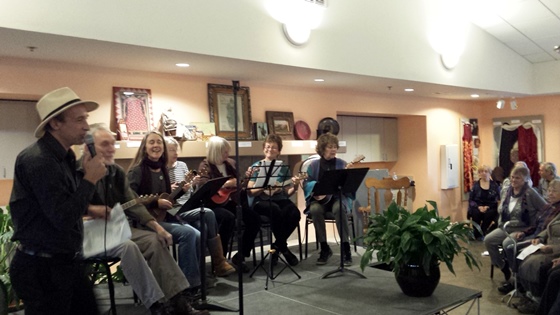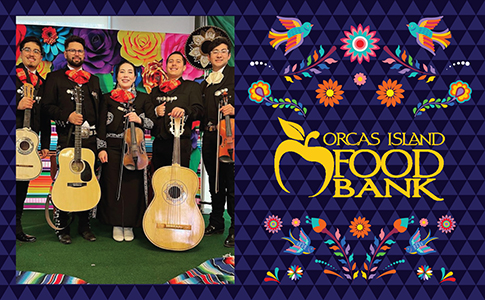— by Matthew Gilbert, Orcas Issues Reporter —
The origin story of most people I know – that is, how they ended up on Orcas Island – usually includes a respectful homage to the archipelago’s natural beauty, isolation, quietude, and topological diversity. The relative simplicity of small-town life is also frequently mentioned: “They even know my name at the Post Office!”
Well it may be time to start kissing some of that eco-hominess goodbye as the world we’ve grown accustomed to starts slipping through our hands. Orcas Island is at a tipping point. Which direction will we fall?
The dictionary definition of accommodate: to make suitable or consistent with one’s circumstances.
My local definition of accommodate: to lay waste to a quality of life through incremental improvements.
I’m hardly an old-timer – I’ve “only” been on Orcas (off and on, but mostly on) for a generation – but I still remember my first day here. Walking down a quiet street to the West Sound Deli; meandering by car along the curvy bi-ways of Horseshoe Highway, staring up at the mountains and out at the water. I could not believe my good fortune.
I still consider myself very lucky that the universe had the good sense to guide me here, but the times they are a changin.’ The genie is out of the bottle. The “secret” of Orcas has long been revealed and we may be standing at a precipice of an irreversible transformation.
It started out slowly at first. A few more cars, a few more driveways, a few more homes. Gradual change, a tweak here, a tweak there. But change begets change, and over the last few years—and especially over the last few months—its effects have noticeably ramped up and I can feel the squeeze:
1. Haven Road: Who would have thought that so many units could fit into such a small space … soon to pulse with traffic and activity.
2. The Port of Orcas: from dog parks and wetlands to hangars and asphalt.
3. April’s pasture: How much of the orchard will remain?
Like many here on the island, I also like to hike, to walk in nature, to be moved by its presence. We are blessed with beautiful lakes and scenic trails. But have you noticed how many new paths there are, branching out, making channels, cutting from one place to another, the shortest route between two points? Wider trails, more trails, our wildness keeps narrowing. Don’t be surprised to see a concession stand at Mountain Lake or motor boats on Cascade.
Not long ago a group of folks floated the idea of helping to address our affordable housing needs by turning Turtleback Mountain into a development. I simply don’t understand that kind of thinking. We do have a legitimate housing crisis, but imagine that island treasure sprouting roads and buildings, forever compromising that special view scape. Fortunately it didn’t happen, but only after considerable effort and angelic intervention. So instead we get in-fill wherever you look – better that than fallow lots or rural encroachment (if you ignore what some of it looks like). And for island visitors who are used to city living, pavement, lines, and traffic, Orcas is still an idyll with plenty of room to breathe. It can certainly accommodate a bit more noise, maybe even a traffic light! But however well-intentioned the efforts to channel growth or minimize its impact, something is being lost, again and again.
The arrival of Oprah – even at one degree of separation– presents us with the “crown jewel” of a certain kind of cultural legitimacy . . . and likely the end of another. As goes Oprah, so goes a big part of the rest of the world. And though the coronae of her impact here on Orcas remains to be seen, I fear (ultimately) the worst.
Washington’s Growth Management Act was less about controlling growth than accommodating it and that continues to be the case. Our population is increasing. The number of truly livable places in the world is shrinking. Our comparatively wet and temperate paradise is becoming a magnet for climate refugees. How much growth is it fair to accommodate and is it possible to draw a line? How far ahead do we need to look? What is our “carrying capacity” and how is that defined? There have been plenty of meetings and plans by well-meaning people with diverse agendas but common interests in preserving our “quality of life” (however that’s measured). But as someone said during a May gathering on the County’s Vision Statement, “Market forces will always trump the best laid plans.”
Despite all our “reasonable” efforts, I’m not convinced there is much we can do to remain good stewards and alter what feels like an inevitable course for our beloved island. Sure, compared to other places it will remain a choice destination and a cut above the rest. We are fortunate to be blessed with world-class festivals, networks of community support, locally grown food, two great markets, a vibrant library, and a new generation of creative energy, to name just a few. I suppose it’s time to adapt, to simply “get over it” and accept the future in all its imperfections. I’m still grateful to be here, this is still a uniquely special place. Maybe the gently intrinsic majesty of the island will endure. Maybe . . .








Well said, Matthew.
Unfortunately, most go through life fulfilling chores, half-dead, but still quite on the move— as if there’s somewhere to go.
If only the impact of how short life is (for them) in their (un)awakened, habitual states would take hold. But, this is not to be.
To demonstrate— even when diagnosed with life threatening diseases, I’ve witnessed a sudden discovery of priorities in others quickly vanish—ephemeral— as each sells out at the first opportunity (upon recovery).
No— if you don’t get it, you never likely did and likely never will—all’s not lost, though.
Do what I do—if you have the financial means move to less developed places around the world and waste not a minute trying to enlighten anyone (It’s not even worth pointing out “a door” much less trying to walk through it for someone —lol)— no—just enjoy the bliss until the development happens wherever you are and peace is replaced with progress—and then move on.
There’s still a few more lifetimes left in certain areas of the world, if you’re interested—see me for details.
It’ll make watching what’s unfolding on Orcas much more palatable and less bothersome to endure.
As Orcas has been the “balancing” sauce for my ultimate on-the-grid life in Manhattan, I’ve found a few more paradisiacal locations around the world that makes the current and coming changes on Orcas much easier to accept.
There’s still orher time zones and places…at least for now.
[Righteousness is an equal opportunity visceral experience and exists in spades on the left every bit as much as it does on the right— while the middle drifts and dithers].
Time to wake up before you’re too old for it to matter.
WTF Chris Graham? That was a poignant probing essay — we have responsibilities for our island/lives — & you come back with a birds eye view of the way your brain works? Think twice — & I don’t mean about yourself.
Don’t mean to offend, Susan.
It’s just no matter what you (you general and plural) say or do (and have said or done),
the contradictions and hypocrisy of “for
growth” positions (whether for the weathy or for affordable housing) head towards ecological collapse.
The tough, sensitive, honest solutions are ones you (generally amd plural) and others similarly situated never address and never will. And I do mean never. Politics is to blame.
Private developers for serious profit never show their cards or openly opine. They know well the “quicksand of contradiction” on which most stand and conclude better to remain incognito.
To them, because you’re not radical enough to be honest about “any and all development,” they conclude they’ll outlast you with their never ending resources and what it buys and influences.
That’s why righteousness is the problem.
It disallows an honest assessment. The left’s position on affordable housing and growth is just as poisonous to the Island’s small footprint as the pro-development of high-end resorts
and vacation rentals—but no one is honest enough to repeat this constantly—not even the island’s environmentalists.
They protect one while they judge the other.
What is that if not politics?
I think the word that describes what’s happening here is “gentrification.” Suddenly we have a theme-park instead of island based in any kind of working-class reality. Nature always falls to the saws to make way for growth and “progress.” Why should people in Doe Bay care about what happens to Eastsound”? We’ve lost “all for one and one for all” – or maybe we never had it. Eastsound Swale – once one of the most high-functioning valuable wetlands in the entire state – has been pillaged for profit. Doe Bay will follow when we’re all used up here.
(BTW the orchard will remain in “April’s Grove.” The forest next to it is where the 45 housing units will go. Ironically, even 100 year old fruit trees can be successfully moved; a forest can’t, so it’s kind of too bad that the cow field wasn’t where the housing would go. But that would violate a “sacred cow!” Someone would have developed and razed the forest anyway, because it’s an “urban growth area” in and around town and it’s all slated for the saws and bulldozers.
I think Chris Graham brings up a salient point about growth – and the hypocrisy on both “sides” – but I’m also bothered by the attitude that select people can pick up and move on (and bring these same problems) to the next “less spoiled” place. What happened to people’s commitment to stand up and stand with the place they love? First Nations understand this love of, and strong tie, to supporting lands and our interconnected with everything on that land; why don’t we?
People on Orcas seem to give up so easily, move on to “the next thing” (and it’s true, there is SO MUCH) and little by little, our collective voice is eroded down to nothing, and a controlled agenda by “higher-up’s” decides the direction we will take because they know they can wear us down and wear us out. And mostly, they’re right. They can and they do.
But what if people really committed to nonstop action and standing up? I don’t hold much faith that it will happen, but i dream of living in a place where it does. I may as well go back to PA – my own homeland and roots place and the land I love most – and fight the frackers. At least there, people are fighting to the end for what they love.
Its not anymore about whether we will win or lose: we will likely lose. It’s more a matter of, will we represent for what we love, or not? That’s the only “victory” left to us and if we don’t do that, for certain, we WILL lose everything we love.
Sadie—I’m not going anywhere (permanently)
and stand ready if my fellow man or woman cares to strike a bold mark before breathing his or her last breath; otherwise, it’s way too short, this life is, for consequential timidity.
Avoidable contradiction and value-less compromise by those who have the capacity to know better disappoints, and holds no value for me—so goes today’s so-called wisdom. It’s utterly unsatisfying.
Mal-education of the nourished is more insidious than the mal-nourishment of the pre-educated.
In the meantime, I’ll not deprive myself of the experience this planet offers in spite of the many deficiencies that abound state-side. Understated and rarified experiences await in some of the least developed and least exposed regions of the world. A means of access?—that’s money’s only value. Were time and access free, I’d ditch the green tool yesterday.
Matthew’s comments are right on the mark – Orcas is growing and therefore changing; the state’s Growth Management requires us to help accommodate the state’s additional growth; and so we fight an uphill battle to maintain what he delightfully describes as the “gently intrinsic majesty” of our Island.
We each can bemoan these changes, but they are not “the problem”. They are merely SYMPTOMS of the underlying problem — which is that just during my lifetime (just a blip in the timeline of our planet) the world’s human population has tripled.
Not surprisingly, this population explosion has led to more carbon fuels being burned, more global warming, more environmental degradation, more pressure on orca whales, more tourists, more houses, etc., etc., etc.
Population growth is not the only cause of these changes, but it is
the most important force that drives them. Yet who among us will stand up and bravely suggest that we actually need to do something about it?
The first politician I heard try to discuss population as an environmental issue was Congresswoman Jolene Unsoeld, from SW Washington. If you’ve never heard of her, that’s because she — and her point of view — were defeated not long thereafter. Since that 1994 election, world population has increased by about 35%.
It’s much safer for politicians, and for those of us having dialogue in forums like this, to stick to “safe” issues like how we can help the whales or manage the Island’s growth . . . while sidestepping the underlying, but very controversial, issue of population growth.
Matthew asked whether it is feasible to limit our Island’s growth. Washington law requires Counties to accommodate growth as long as the state’s population is growing. So: the answer is probably no, unless we either change the law or (finally) heighten public awareness about population issues.
BINGO!
Douglas- why haven’t I read this kind of comment before now. Do others feel as you do? You speak so honestly and bravely in talking about population growth. Yes, the challenge may be impossible to meet but thank you deeply for identifying the primary driver of what will do us in. Why can’t our scientists and environmentalists be this brave? Even if they have no answer—at least name it correctly! and don’t blame, deflect and distract us to focus on mere “tributaries” of harm for political gain or pacification while the main “source” remains unspeakable as in the proverbial third rail. Thank you.
And thank you Matthew for having the decency to write this editorial…I took for granted the fact that you pulled this together with such careful wording,
for instance, ”Death by Accommodation”— how precise and powerful are these three words.
Chris — do you actually live here? If you did, you would already know about the tremendous talent here and wouldn’t be so surprised: Doug, Matthew, Sadie, Michael, Fred, Joe, Ellie, Learner, David, and on and on and on and on….
BTW, thank you, Matthew, for another really powerful, beautifully written piece.
Reply to Neil: I merely suggested that we “heighten public awareness about population issues”, including the tripling of the world’s population during my life time — and you responded by implying that I advocate “controlling” population, or argue for “mass suicide” or “state killing of people at a certain age”. You have demonstrated why it is so difficult to have an intelligent conversation about overpopulation. It is simply not constructive to try to shout down my concerns aby (falsely) suggesting I must be advocating murder!!
Look: We have taught kids about what plastics in the ocean have done to birds and whales, and they responded by cleaning up beaches and advocating an end to plastic straws. But many of them grow up in a family with lots of kids and they think that’s normal and good. How would they respond if “we” (their parents, their friends, the media, their peers) were to promote amore awareness of the environmental implications of overpopulation, and help the younger generations understand the consequences if the population were to triple (again) during THEIR lifetimes??
I am optimistic that more discussion of these consequences would (voluntarly) result in a declining birth rate, and a stabilization of total population. Unless it stabilizes, the ice caps will continue to melt away — no matter how many Priuses we buy, no matter how many of us live in tiny houses, no matter how many of us live off the grid. Sustainable living might delay the problem, but it would be overwhelmed by another tripling of the world’s population. I’m sure you can see that. I’m sure you can do your part to help.
Neil, ol’ Mother Nature has tried her best to reduce the world’s too-rapidly-growing population by means of repeated famine and disease, but we keep defeating her.
While eugenics, euthanasia, and genocide are quite obviously morally indefensible, perhaps a hands-off attitude might be acceptable.
It’s just a thought to explore and discuss.
Although a newbie to the island, I am experienced in devastating growth from my former mountain town.
The answer seems simple to me. Reroute lodging taxes from marketing to affordable housing efforts. Let us locals return airbnb rentals back to homes for local workers.
Let’s stop complaining and take action.